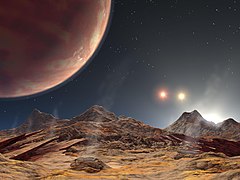HD 188753 A b
 Artystyczna wizja planety oglądanej z powierzchni jej hipotetycznego księżyca z widocznym potrójnym zachodem słońca (Źródło:NASA/JPL-Caltech) | |
| Odkrywca | |
|---|---|
| Data odkrycia | 14 lipca 2005 |
| Charakterystyka orbity (J2000) | |
| Półoś wielka | 0,0446 ± 0,0010 au |
| Mimośród | 0 |
| Okres orbitalny | 3,3481 ± 0,0009 |
| Charakterystyka fizyczna | |
| Masa minimalna (M·sin i) | 1,14 ± 0,10 MJ |
| Temperatura powierzchni | ~720 K |
HD 188753 A b (inne nazwy: Ho 581 Ab, BD+41°3535 Ab oraz Tatooine) – hipotetyczna planeta pozasłoneczna okrążająca gwiazdę HD 188753 A, której odkrycie zostało ogłoszone 14 lipca 2005 przez doktora Macieja Konackiego, polskiego astronoma pracującego w Stanach Zjednoczonych.
Jeśli istnienie planety zostanie potwierdzone, będzie to druga planeta znajdująca się w potrójnym układzie gwiazdowym, po 16 Cygni B b. HD 188753 Ab należy do grupy tzw. gorących jowiszy, gazowych olbrzymów orbitujących bardzo blisko głównej gwiazdy. Potrzebuje ona zaledwie 3,3 dnia na wykonanie pełnego obiegu wokół gwiazdy, w odległości równej trzydziestej części dystansu między Ziemią a Słońcem. Temperatura powierzchni planety wynosi około 720 K.
Wokół gwiazdy centralnej krąży układ podwójny gwiazd z okresem wynoszącym 25,7 lat, a dwie gwiazdy tworzące ten układ obiegają wspólny środek masy w czasie 156 dni. Układ HD 188753 znajduje się 149 lat świetlnych od Ziemi w konstelacji Łabędzia.
Nazwa
Oficjalną nazwą planety jest HD 209458 b, utworzona z oznaczenia gwiazdy w katalogu Henry’ego Drapera. Litera A jest standardowym oznaczeniem dla gwiazdy, wokół której krąży, co jest spowodowane położeniem w układzie wielokrotnym, natomiast litera b jest oznaczeniem dla pierwszej odkrytej planety w tym układzie. Innymi nazwami planety są Ho 581 Ab i BD+41°3535 Ab.
Planeta jest także nazywana Tatooine, co jest nawiązaniem do fikcyjnej planety z sagi Gwiezdnych wojen. Obie planety znajdują się w układzie wielokrotnym, co było powodem nadania jej takiej nazwy. W przeciwieństwie do planety z filmu, HD 188753 A b znajduje się w układzie potrójnym, podczas gdy Tatooine w układzie podwójnym.
Kontrowersje
W lutym 2007 roku zespół Anne Eggenberger opublikował wyniki swoich badań, wskazujące, że w układzie HD 188753 nie ma żadnej planety. W swojej odpowiedzi[1] dr Konacki zaznaczył, że grupa ta posługiwała się mniej dokładnym sprzętem i jej wnioski są zbyt daleko idące, ale dalsze badania tego systemu są przewidziane. Raport z 2009 roku[2], oparty na wcześniejszych pomiarach zespołu Eggenberger, ponownie nie potwierdza istnienia tej planety.
Przypisy
- ↑ Maciej Konacki: An extrasolar giant planet in a close triple-star system HD188753. [dostęp 2008-03-26]. [zarchiwizowane z tego adresu (2008-04-20)].
- ↑ T. Mazeh, Y. Tsodikovich, et al.: TRIMOR - three-dimensional correlation technique to analyze multi-order spectra of triple stellar systems; Application to HD188753. arXiv, 20.07.2009.
Linki zewnętrzne
- HD 188753 A b w serwisie The Extrasolar Planets Encyclopaedia (ang.)
- Strona internetowa Macieja Konackiego (ang.). [dostęp 2013-12-17]. [zarchiwizowane z tego adresu (2015-04-03)].
- NASA Scientist Finds World With Triple Sunsets (ang.)
Media użyte na tej stronie
Artist's conception of the three suns and the newly discovered Jupiter-sized planet from the perspective of a hypothetical moon orbiting the planet. The large yellow sun is already halfway over the horizon. The orange and red suns are still visible in the sky. This artist's animation shows the view from a hypothetical moon in orbit around the first known planet to reside in a tight-knit triple-star system. HD 188753 Ab is a gas giant planet, about 1.14 times the mass of Jupiter, with an orbital period of 3.3 days discovered using the Keck I telescope atop Mauna Kea in Hawaii, and zips around a single star that is orbited by a nearby pair of pirouetting stars. Because the stars in this triple system are bunched together, sunsets on the planet -- or on any moons that might exist around the planet -- would be spectacular. This rambunctious stellar family is called HD 188753 and is located 149 light-years away in the constellation Cygnus.
In this movie, sunset is seen through the tenuous atmosphere of a hot, baked hypothetical moon. As the suns dip below the horizon, the gas giant comes into view. The moon's landscape remains illuminated by sunlight reflected off the planet. Both the planet and moon would be so hot that even in shadow their surfaces would glow.
The suns' colors and sizes reflect their masses, temperatures and distances to the planet. For example, the first star shown setting over the horizon is the closest, most massive and hottest of the trio, so it is depicted as large and white. The second star is farther away, less massive and cooler than the first, appearing smaller and yellow. The final star is at the same distance as the second, but it is still less massive and cooler, appearing even smaller and orange-red in color. Our Sun is a bit cooler than the hottest star of the system.
The graph in figure 1 shows the "wobble" of a star being tugged on by the planet called HD 188753 Ab. The planet was discovered via the radial velocity technique, in which a planet's presence is inferred by the motion, or wobble, it causes in its parent star. Stellar motion is plotted here as changes in velocity (y-axis) versus time (x-axis).
Unlike most planetary wobbles, this one comes from a star that is circled by a nearby pair of stars. In other words, the planet orbits a single star that is part of a close-knit triple-star system. Because the starlight from this cramped bunch blends together, the task of sifting through the light to find the planet's signature was more difficult. This challenge was overcome with the help of detailed models of the triple-star system's light. Data from those models resulted in precise velocity measurements of the star circled by HD 188753 Ab.
Note: The size of the Full-Res TIFF for the still image is 3200 samples x 2400 lines.